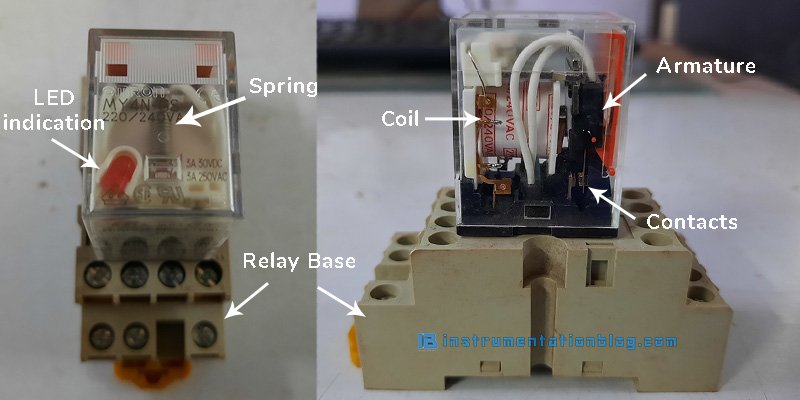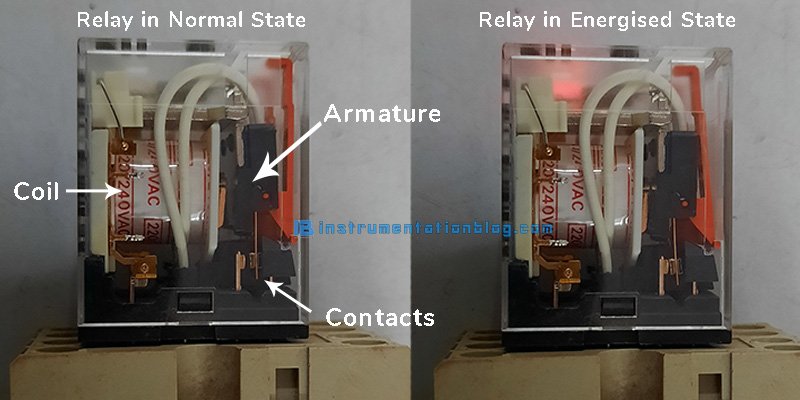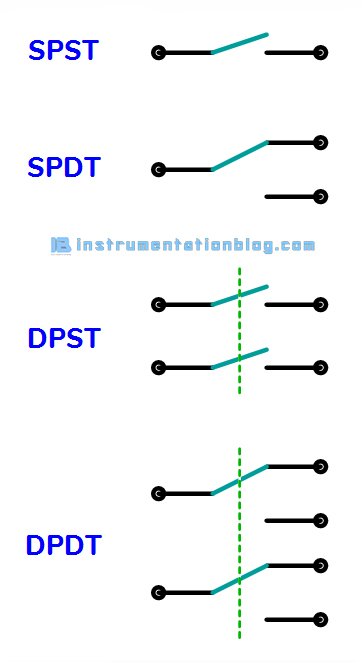Hey friends! How are you all?
In the electrical field, you have heard many times the word “Relay”. In this article, we are going to see all the details like What is Relay?, Relay Construction, Relay Working, Relay Operation, Relay Applications, etc.
Table of Contents
What is Relay? | Relay Working and it’s Types
A relay is an electromagnetic switch operated by a relatively small current that can turn on or off much larger current.
The main part of the relay is an electromagnet, a coil of wire that works like a magnet when the current flowing through it.
Relays are generally used where it is necessary to control a circuit by a separate low power signal.
Relay Construction
Almost all the relays work on the same principle but there are different types of relays are available in the market. I am going to give you a basic example of a simple glass relay here.

As you have seen in the above image, the main parts of the relays are
Coil ⇒ The coil is the wire wound around the metal and when the sufficient electrical power supply passes through this it acts as a magnet.
Moving Armature ⇒ There is a moving part in the relay which opens and closes the contacts. An attached spring keeps the armature to its original position in normal condition.
Switch Contacts ⇒ The relay is a switch, there must be contacts that are generally used to control another circuit. There are mainly two contacts: Normally Open and Normally Closed.
Relay Housing ⇒ The assembly of the armature with a magnetic coil is made with the help of spring. The spring is insulated from the armature by molded block and the switch contacts are usually spot welded on the terminal link.
Relay Operation (Relay Working)
A relay is an electromagnetic switch, a user can turn it ON or OFF depends on the logic.

Relay has an electromagnetic coil, there are mainly two conditions like
⇒ When power flows through this coil it generates a magnetic field that attracts the armature and makes the contact.
⇒ When there is no power to the electromagnetic coil, the armature rests its position and breaks the contact.

On the above image, we can see that relay is in the normal state on the left side and the contacts are open in this state. While on the right-side relay is in the energized state and contacts are closed. Also, the led are glowing which indicates the relay is energized.
Pole and Throw in Relay
Relay working is like a switch. There are two main concepts in the relay that are pole and throw, where the pole is like a switch and throw is a number of connections.
Normally Open Contact ⇒ Normally open contact is also called as a NO contact. It closes the circuit when a relay is activated or energized and disconnects the circuit when a relay is in a normal state.
Normally Closed Contact ⇒ Normally open contact is also called as an NC contact. It disconnects the circuit when a relay is activated or energized and closes the circuit when a relay is in a normal state.
Common Contact ⇒ Common contact is only there when the relay has a double throw. In this type of relay, you will find both the Normally open and Normally closed contact with one common terminal.
Common contact is connected with the normally closed contact during the normal state of the relay and when the relay is energized common contact brakes the contact with normally closed contact and makes the contact with normally open contact.
A relay can be used with several circuits by just one signal, for that relay must have multiple poles like,
Each of these types of relay has two terminals for a coil. But except the coil, it has other terminals for switching contacts.
Single Pole Single Throw(SPST) ⇒ Except for the coil terminals, SPST has two more terminals.
Single Pole Double Throw(SPDT) ⇒ Except for the coil terminals, SPDT has three more terminals. There is an additional common contact with the normally open and normally closed contacts.
Double Pole Single Throw(DPST) ⇒ Except for the coil terminals, DPST has four more terminals. There are two poles here, so this type of relay can operate two different electrical circuits.
Double Pole Double Throw(DPDT) ⇒ Except for the coil terminals, DPDT has six more terminals. There are two poles here and additionally common contact in each pole with normally open and normally closed contacts.

Types of Relay
Till now we see a general switching relay, but in the market, you will find other variation of the relay like,
⇒ High Voltage Relay
⇒ Solid State Relay
⇒ Thermal Overload Relay
⇒ Differential Protection Relay
⇒ Over-current Relay
⇒ Frequency Protection Relay
⇒ Time-Delay Relay
You will find the different types of relays available in the market by clicking here.
Relay Applications
⇒ Relays are generally used to isolate low voltage circuit from high voltage circuit.
⇒ Relays are used for controlling multiple circuits.
⇒ Microprocessor-based relays are used to protect heavy-load circuits.
⇒ Overload relays are used to protect motors, circuit-breakers from high-current and electrical failure.
I hope you like this blog about relay working and operation. Explore more blogs like,
- What is PLC? How does it work?
- Sinking vs Sourcing in PLC
- Bit Logic Instructions
- PLC Timer and PLC Counter
- Closed-loop vs Open-loop
- PLC Programming Blocks
You can read more articles about Instrumentations and find the books that boost your knowledge in the field of instrumentation ⇒
